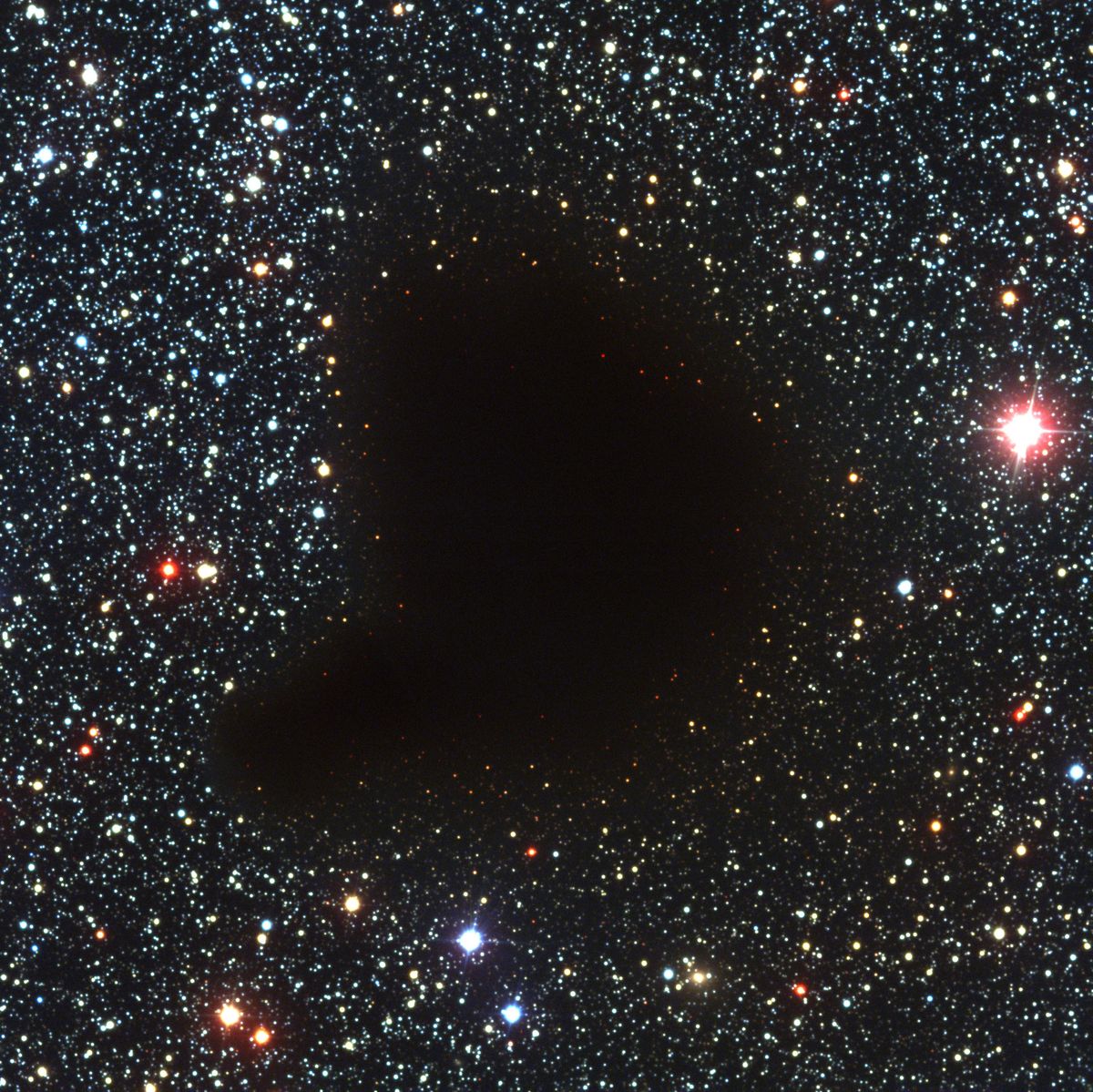ท่ามกลางความสุกสว่างของดวงดาวนับล้านในแถบทางช้างเผือก ปรากฏวัตถุอันน่าพิศวงคล้าย “หลุมดำ” ในห้วงอวกาศ นั่นคือ กระจุกเมฆมืดที่นักดาราศาสตร์รู้จักกันในชื่อ บาร์นาร์ด 68 (Barnard 68) ภาพถ่ายอันงดงามนี้ได้เผยให้เห็นรูปร่างที่ทึบแสงและขอบเขตที่คมชัดของมัน ซึ่งโดดเด่นตัดกับพื้นหลังของดาวฤกษ์อันมากมาย
เอดเวิร์ด อี. บาร์นาร์ด (Edward E. Barnard) นักดาราศาสตร์ชาวอเมริกัน เป็นผู้ที่ได้รวบรวมและจัดทำบัญชีรายชื่อวัตถุมืดเหล่านี้ไว้ตั้งแต่ปี ค.ศ. 1919 ในอดีต นักวิทยาศาสตร์เคยเชื่อว่าเมฆมืดเหล่านี้เป็นเพียงรูที่ว่างเปล่าในห้วงอวกาศ แต่ปัจจุบันเราทราบดีว่ามันคือกลุ่มก้อนของก๊าซและฝุ่นละอองหนาแน่น รวมถึงโมเลกุลต่างๆ ที่มีอะตอมของคาร์บอนเป็นองค์ประกอบ ซึ่งทำให้พวกมันมีอุณหภูมิต่ำมาก ราว -263 องศาเซลเซียส (-263 °C) หรือประมาณ 10 เคลวิน (Kelvin)
สิ่งที่น่าสนใจยิ่งกว่านั้นคือ เมฆโมเลกุลเหล่านี้เป็นเสมือนสถานรับเลี้ยงเด็กของดาวฤกษ์และดาวเคราะห์ดวงใหม่ นักดาราศาสตร์เชื่อว่าภายใต้สภาวะที่เหมาะสม แรงโน้มถ่วงจะเริ่มดึงดูดมวลสารภายในเมฆเข้าหากัน จนกระทั่งมีความหนาแน่นและอุณหภูมิสูงเพียงพอที่จะจุดปฏิกิริยานิวเคลียร์ฟิวชัน (nuclear fusion) ณ แกนกลาง ก่อกำเนิดเป็นดาวฤกษ์ที่ส่องสว่างในที่สุด
แต่กระบวนการที่เมฆมืดอย่างบาร์นาร์ด 68 เริ่มต้นการยุบตัวและพัฒนาไปเป็นดาวฤกษ์ยังคงเป็นปริศนาที่ท้าทาย การศึกษาภาพถ่ายความละเอียดสูง เช่น ภาพที่ได้จากอุปกรณ์ FORS1 บนกล้องโทรทรรศน์ Very Large Telescope ณ หอดูดาวท้องฟ้าซีกใต้แห่งยุโรป (European Southern Observatory – ESO) อาจเป็นกุญแจสำคัญในการไขความลับนี้
Barnard 68 เป็นกระจุกเมฆขนาดเล็ก มีเส้นผ่านศูนย์กลางเพียงประมาณ 7 เดือนแสง หรือราว 0.2 พาร์เซก (หน่วยวัดระยะทางทางดาราศาสตร์) ตั้งอยู่ห่างจากโลกของเราประมาณ 500 ปีแสง ในทิศทางของกลุ่มดาวคนแบกงู (Ophiuchus) นักวิทยาศาสตร์คาดการณ์ว่าเมฆแห่งนี้อาจอยู่ในช่วงเริ่มต้นของการยุบตัว ซึ่งเป็นขั้นตอนแรกในการก่อกำเนิดดาวฤกษ์
ภาพอันน่าทึ่งนี้ได้จากการนำภาพที่ถ่ายผ่านแผ่นกรองแสงสีน้ำเงิน (Blue), สีเขียวเหลือง (Green-Yellow) และรังสีอินฟราเรดใกล้ (Near-Infrared) มาประกอบกัน ทำให้เราได้เห็นรายละเอียดของเมฆมืดแห่งนี้ ซึ่งครอบคลุมพื้นที่บนท้องฟ้าเพียงเล็กน้อยเท่านั้น
การศึกษาเมฆมืดเช่น Barnard 68 ช่วยให้นักดาราศาสตร์เข้าใจกระบวนการก่อตัวของดาวฤกษ์และระบบดาวเคราะห์ ซึ่งเป็นรากฐานสำคัญของจักรวาลที่เราอาศัยอยู่ การไขปริศนาเหล่านี้จะนำไปสู่ความเข้าใจที่ลึกซึ้งยิ่งขึ้นเกี่ยวกับวิวัฒนาการของเอกภพและตำแหน่งของเราในจักรวาลอันกว้างใหญ่
แหล่งข้อมูล: หอดูดาวท้องฟ้าซีกใต้แห่งยุโรป (European Southern Observatory – ESO)




